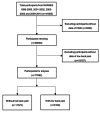Association between different composite dietary antioxidant indexes and low back pain in American women adults: a cross-sectional study from NHANES
- PMID: 38200420
- PMCID: PMC10782773
- DOI: 10.1186/s12889-024-17649-0
Association between different composite dietary antioxidant indexes and low back pain in American women adults: a cross-sectional study from NHANES
Abstract
Background: Low back pain is the leading cause of productivity loss, imposes a significant economic burden on the patients and society. Oxidative stress is considered a critical factor in the complex pathophysiological process and pathogenic mechanism of low back pain. Adjustment dietary pattern can effectively increase antioxidant biomarkers levels within the body to reduce oxidative stress. The composite dietary antioxidant index (CDAI) serves a reliable scoring system for quantifying the potential dietary antioxidant capacity of daily diets.
Objective: We aim to investigate the potential association between CDAI and low back pain, in order to enhance the management of low back pain through dietary guidance.
Methods: This study included 17,682 participants from the National Health and Nutrition Examination Survey (NHANES) 1999-2000, 2001-2002, 2003-2004 and 2009-2010. The weighted logistic regression model was used to investigate the association between CDAI and low back pain, while restricted cubic spline (RCS) was employed to examine non-linear trend and cutoffs.
Results: After adjusting for all confounders, the results showed that there was no significant association between CDAI and low back pain. However, individuals in the highest quartile of CDAI exhibited an 11.7% less likelihood of experiencing a low back pain than those in the lowest quartile (OR = 0.883; 95% CI [0.787,0.991], P = 0.034), and the trend test was also significant (P for trend < 0.001). RCS indicated a linear relationship between CDAI and low back pain (P for non-linear = 0.876). Gender subgroup analysis showed that this negative association was significant in the female population (OR = 0.983; 95% CI [0.968, 0.998], P = 0.027), and females in the highest quartile of CDAI were 19.7% less likely to suffer low back pain than those in the lowest quartile (OR = 0.803; 95% CI [0.682,0.945], P = 0.008). Additionally, the changes in zinc (OR = 1.009; 95% CI [1.002, 1.016], P = 0.015) and selenium (OR = 0.379; 95% CI [0.164, 0.875], P = 0.023) per milligram were independently associated with low back pain.
Conclusion: The fully adjusted model showed no significant association between CDAI and low back pain, but it was significant in quartiles. Meanwhile, subgroup analysis by gender revealed a negative association between CDAI and low back pain in the female population. Additionally, the findings of this study also suggested that the antioxidant diets should be studied in a dietary pattern context.
Keywords: Antioxidant; Composite dietary antioxidant index (CDAI); Low back pain; National Health and Nutrition Examination Survey ( NHANES); Oxidative stress.
© 2024. The Author(s).
Conflict of interest statement
The authors declare no competing interests.
Figures


Similar articles
-
Association between different composite dietary antioxidant indexes and constipation in American male adults: a cross-sectional study.Front Nutr. 2024 Jul 18;11:1404400. doi: 10.3389/fnut.2024.1404400. eCollection 2024. Front Nutr. 2024. PMID: 39091680 Free PMC article.
-
Association between composite dietary antioxidant index and epilepsy in American population: a cross-sectional study from NHANES.BMC Public Health. 2024 Aug 17;24(1):2240. doi: 10.1186/s12889-024-19794-y. BMC Public Health. 2024. PMID: 39154181 Free PMC article.
-
Association between composite dietary antioxidant index and hyperlipidemia: a cross-sectional study from NHANES (2005-2020).Sci Rep. 2024 Jul 10;14(1):15935. doi: 10.1038/s41598-024-66922-0. Sci Rep. 2024. PMID: 38987566 Free PMC article.
-
Association between composite dietary antioxidant index and handgrip strength in American adults: Data from National Health and Nutrition Examination Survey (NHANES, 2011-2014).Front Nutr. 2023 Mar 31;10:1147869. doi: 10.3389/fnut.2023.1147869. eCollection 2023. Front Nutr. 2023. PMID: 37063339 Free PMC article.
-
Bone mineral density is associated with composite dietary antioxidant index among US adults: results from NHANES.Osteoporos Int. 2023 Dec;34(12):2101-2110. doi: 10.1007/s00198-023-06901-9. Epub 2023 Sep 4. Osteoporos Int. 2023. PMID: 37666910
Cited by
-
Association of composite dietary antioxidant index and endometriosis risk in reproductive-age women: a cross-sectional study using big data-machine learning approach.Front Nutr. 2025 Mar 27;12:1572336. doi: 10.3389/fnut.2025.1572336. eCollection 2025. Front Nutr. 2025. PMID: 40212718 Free PMC article.
-
Association between the composite dietary antioxidant index and all-cause mortality in individuals with osteoarthritis via NHANES data.Sci Rep. 2024 Dec 5;14(1):30387. doi: 10.1038/s41598-024-81871-4. Sci Rep. 2024. PMID: 39639118 Free PMC article.
-
Association between the composite dietary antioxidant index and non-alcoholic fatty liver disease: evidence from National Health and Nutrition Examination Survey 2005-2016.Front Nutr. 2025 Jan 23;12:1473487. doi: 10.3389/fnut.2025.1473487. eCollection 2025. Front Nutr. 2025. PMID: 39917746 Free PMC article.
-
Global, regional, and national burdens of low back pain in women of childbearing age from 1990 to 2021: an analysis based on the global burden of disease study 2021.BMC Public Health. 2025 Feb 7;25(1):515. doi: 10.1186/s12889-025-21659-x. BMC Public Health. 2025. PMID: 39920629 Free PMC article.
-
Sugar-sweetened beverage intake and chronic low back pain.Front Nutr. 2024 Jul 3;11:1418393. doi: 10.3389/fnut.2024.1418393. eCollection 2024. Front Nutr. 2024. PMID: 39021606 Free PMC article.
References
-
- GBD 2017 Disease and Injury Incidence and Prevalence Collaborators Global, regional, and national incidence, prevalence, and years lived with disability for 354 diseases and injuries for 195 countries and territories, 1990–2017: a systematic analysis for the global burden of Disease Study 2017. Lancet Lond Engl. 2018;392:1789–858. doi: 10.1016/S0140-6736(18)32279-7. - DOI - PMC - PubMed
Publication types
MeSH terms
Substances
Grants and funding
LinkOut - more resources
Full Text Sources
Medical

